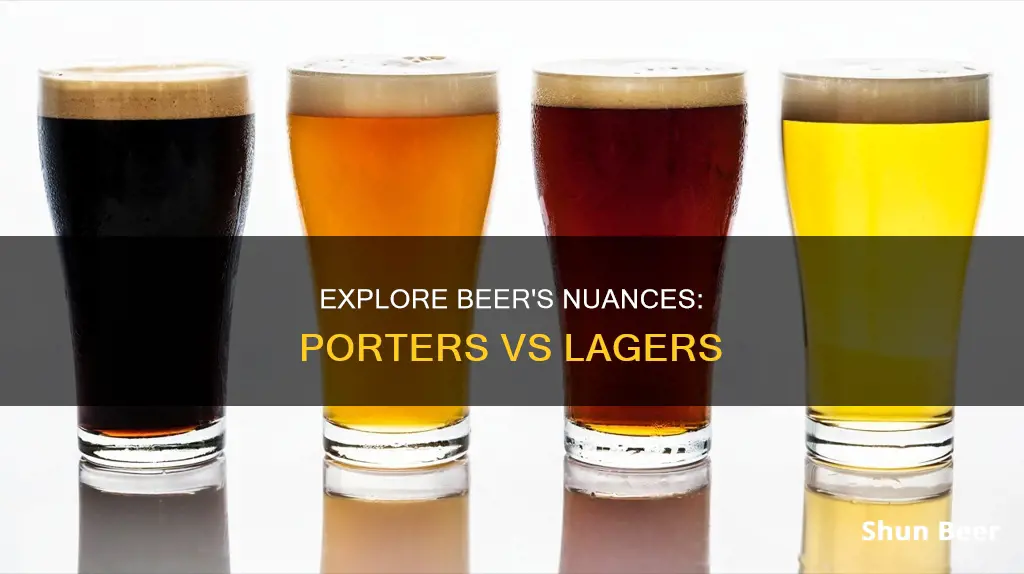
Beer is one of the world's oldest drinks, with the first barley beer production dating back to around 4,000 BCE in ancient Sumeria. Today, beer can be broadly categorised into two types: lagers and ales. Lagers are fermented with bottom-fermenting yeast at cold temperatures, whereas ales are fermented with top-fermenting yeast at warm temperatures. Porters, a type of ale, are known for their dark black colour and roasted malt aroma. They are fermented with dark malted barley, hops, and top-fermenting ale yeasts. The original porter was created in London in the early 1700s, and the style has since undergone many transformations, with modern interpretations varying in taste.
What You'll Learn

Porters are ales, lagers are not
Porters and lagers are two distinct styles of beer with different histories, brewing processes, and characteristics. While porters are ales, lagers are not, and understanding this difference is key to distinguishing between the two.
Firstly, it is important to know that all beers can be categorised as either lagers or ales, with some rarer hybrid styles also existing. Ales are the oldest style of beer, and porters fall into this category. Porters are ales that are brewed with dark malted barley, hops, and top-fermenting ale yeasts. The name "porter" is believed to have originated from its popularity with porters in London, England, in the early 18th century.
The brewing process for ales, including porters, involves fermenting with top-fermenting yeast at warm temperatures of around 60˚–70˚F (15.5˚–21˚C). This warm and complex process results in beers with a rich aroma and flavour. In contrast, lagers are fermented with bottom-fermenting yeast at cold temperatures of approximately 35˚–50˚F (1.5˚–10˚C). The cold and efficient lager brewing process produces beers that are simple, clear, clean, and refreshing.
The difference in yeast and fermentation methods gives porters and lagers distinct characteristics. Porters are typically very dark, with a mild flavour and thin mouthfeel, while lagers are lighter in colour and have a crisp, clean taste. Porters may exhibit fruity or spicy flavours due to the variety of roasted malt used, whereas lagers tend to have a lighter aroma and flavour, with little residual sweetness.
In summary, the key distinction between porters and lagers is that porters are ales, while lagers are a separate category. This fundamental difference in classification results in variations in their brewing processes, sensory attributes, and overall drinking experience.
Oklahoma Beer: Unique Taste or Marketing Ploy?
You may want to see also

Porters are darker and heavier than lagers
Porters and lagers are two distinct styles of beer, with notable differences in appearance, flavour, and overall profile. One of the most noticeable differences is that porters are darker and heavier than lagers.
Porters, first brewed in London, England, in the 18th century, are known for their dark colour and robust flavour. They are typically fermented with dark malted barley, hops, and top-fermenting ale yeasts. Over time, the style has evolved, and today, porters can vary significantly in taste. Generally, porters are very dark, with mild flavours and a thin consistency, though not watery. They often exhibit fruity or spicy notes, with hints of caramel and chocolate.
In contrast, lagers are lighter and cleaner in appearance and flavour. They originated in Germany, where Bavarian brewers discovered that "lagering", or ageing beer after the initial fermentation, resulted in a cleaner, less susceptible-to-contamination beer. Lagers are fermented with bottom-fermenting yeasts that sink to the bottom of the fermentation tank and work more slowly and at cooler temperatures than ale yeasts. This results in a beer with little to no residual sweetness and a light aroma and flavour.
The difference in yeast and brewing processes between porters and lagers leads to distinct sensory experiences. Porters, with their dark malted barley and top-fermenting yeasts, produce a darker, heavier beer with a fruitier and spicier flavour profile compared to lagers. The longer fermentation time and lower temperatures used in lager production result in a lighter-coloured, cleaner, and crisper beer.
While porters and lagers have distinct characteristics, the terms "stout" and "porter" are often used interchangeably today to refer to any dark, richly flavoured beer. This blurs the lines between the two styles, as some porters may contain more roasted barley, making them similar in colour and flavour to stouts.
Beer vs Lager: What's the Difference?
You may want to see also

Porters are fruitier and spicier than lagers
Porters and lagers are two distinct styles of beer with their own unique characteristics. One of the most noticeable differences is that porters are often perceived as having fruitier and spicier flavours compared to lagers. This fruitiness is a result of the specific brewing process and ingredients used in creating porters.
Porters are a type of ale, which means they are fermented with top-fermenting yeast at warmer temperatures, typically between 60°F and 70°F. This warm and complex brewing process contributes to the development of the rich, fruity, and spicy flavours that porters are known for. Additionally, porters are often made with dark malted barley, which imparts a darker colour and contributes to the overall flavour profile.
The history of porters can be traced back to early 18th-century London, England, where they were extremely popular. Over time, porters have evolved and spread worldwide, with different interpretations of the brew leading to a variety of tastes. While porters can vary in flavour, they are typically known for their dark colour, mild flavour, and thin yet not watery texture.
Lagers, on the other hand, have a different flavour profile. They are characterised by their clean, crisp, and refreshing qualities. Lagers originated in Germany, where Bavarian brewers discovered that "lagering", or aging beer after initial fermentation, resulted in a cleaner-tasting beer that was less prone to contamination.
Lager yeasts, or Saccharomyces pastorianus, behave differently from ale yeasts. Lager yeasts flocculate at the bottom of the fermentation tank and thrive at lower temperatures. This aggressive fermentation process results in minimal residual sweetness and flavour, leading to the clean and crisp characteristics of lagers. The combination of lager yeasts and a cold, efficient brewing process results in the light aroma and flavour typically found in lagers.
While porters are fruitier and spicier than lagers, it's important to note that both styles have their own dedicated fan base. The world of beer is diverse, and the differences between porters and lagers showcase the art and science of brewing, where subtle variations in ingredients, yeast, and processes can lead to distinct flavour profiles.
Pilsner vs Lager Beer: What's the Difference?
You may want to see also

Porters are fermented with dark malted barley
Porters are ales fermented with dark malted barley, hops, and top-fermenting ale yeasts. The process of malting involves soaking the barley, allowing it to germinate, and then halting the germination process with heat. The amount of heat applied to the barley malt has a significant impact on the colour of the resulting beer. For example, lightly roasted malt produces a very pale beer, whereas deeply roasted malts produce dark or black beers.
The highest temperatures are used to make the darkest, almost black, beers, including porters and stouts. Porters are characterised by their chocolatey flavour and smooth texture, with hints of coffee and roasted nuts. The distinctive flavour of porters is achieved through the use of dark malted barley, which also contributes to their darker colour.
The key ingredients in a porter include base malts, such as Maris Otter or US two-row, which provide the fermentable sugars. Specialty malts like Crystal, Brown, Chocolate, and Black malts add colour, flavour, and aroma. Hop varieties, such as Fuggles, Goldings, and East Kent Goldings, are used for bitterness and aroma, while ale yeast ferments the sugars into alcohol.
The specific combination of malts and hops used in a porter can result in a wide range of flavours within the porter category, from sweet and malty to dark and roasty. Porters are known for their chocolatey, malty flavours and smooth, medium body, setting them apart from stouts, which tend to have a more robust, roasted coffee flavour.
Soju and Beer: What Sets Them Apart?
You may want to see also

Lagers are more popular globally than porters
In contrast, porters are ales, which are the oldest kind of beer. Ales are fermented with top-fermenting yeasts at higher temperatures and for shorter periods than lagers. Porters are also darker and fruitier than lagers, with a more robust and complex flavour profile. While porters were once the most popular beer in America and England, they have since been overtaken in popularity by lagers.
The global lager market size reached US$328.4 billion in 2021 and is expected to continue growing. Lagers are particularly common in European countries such as the Czech Republic, Germany, and the Netherlands, as well as in Canada, where they make up more than half of all beer sales. This widespread popularity is due in part to the crisp, clean taste of lagers, which is achieved through the use of lager yeasts and a cold and efficient brewing process.
Lagers are also more affordable to produce than craft beers, which are almost exclusively ales. Lagers can be fermented, hopped, and canned in just a few weeks, whereas craft beers, such as porters, take longer and require more expensive ingredients and processes. As a result, lagers have become the dominant global style of beer, with their thirst-quenching capabilities appealing to a wide range of consumers.
Heineken's Unique Brewing Process: What Sets it Apart?
You may want to see also
Frequently asked questions
Lagers are a newer style of beer that originated in Germany. They are fermented at low temperatures (35˚–50˚F) and rely on bottom-fermenting yeasts, which sink to the bottom of the fermenting tank. Lagers are typically light in aroma and flavour and are served cold.
Porter is a style of beer that was first brewed in London, England, in the early 18th century. It is an ale fermented with dark malted barley, hops, and top-fermenting ale yeasts. Porters are normally very dark, mild in flavour, and thin but not watery.
Porters and lagers differ in terms of their yeast and brewing processes, as well as their appearance, smell, and taste. Porters are darker, fruitier, and spicier than lagers. They tend to be heavier, more robust, and complex, while lagers are cleaner and crisper.







